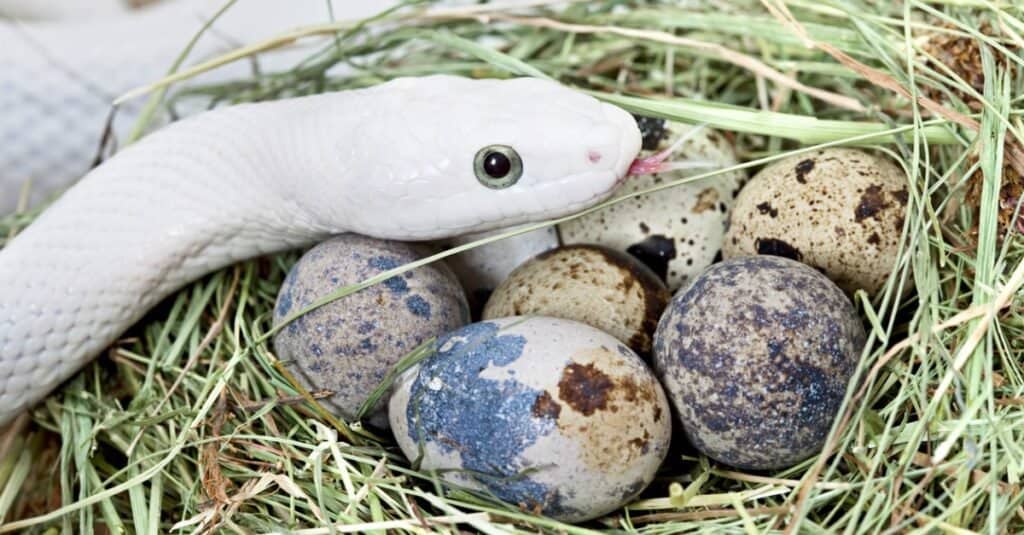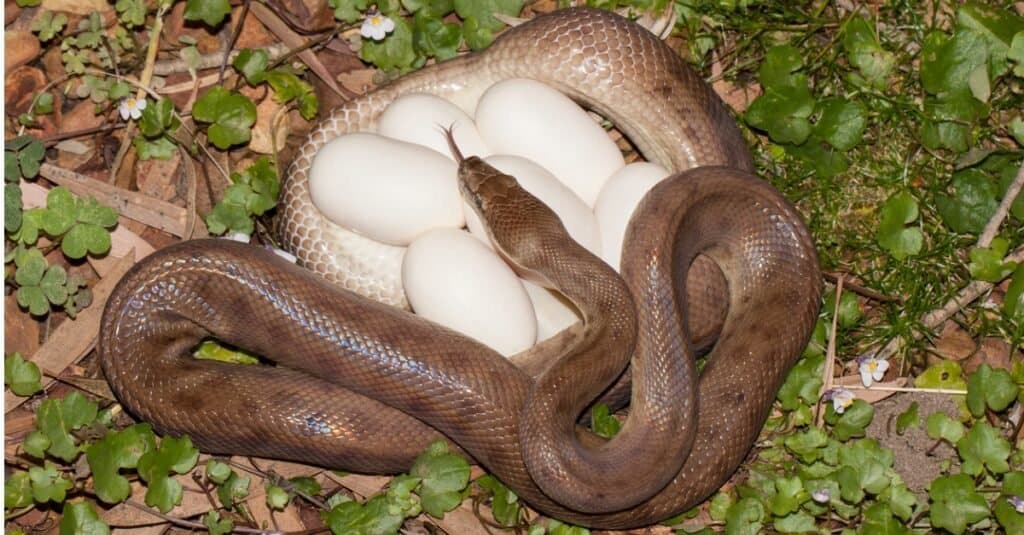When it comes to identifying snake eggs vs lizard eggs, the differences can be subtle. Both of these reptiles have the ability to lay eggs, while some snakes and lizards also give birth to live young. But what do you do if you find some eggs unattended and you aren’t sure whether they are snake or lizard eggs?
Let’s discuss the differences between snake eggs vs lizard eggs, as they are difficult to tell. Comparing these two egg types can be extraordinarily tricky, even for experts! Unless you are able to candle the eggs to better tell the species within, you might not even know what lies within.
However, it’s important to try to identify these reptilian eggs, so let’s take a look at some potential distinguishing features now.
Comparing Snake Eggs vs Lizard Eggs

| Snake Eggs | Lizard Eggs |
| Incubation time 50-60 days | 40-80 days |
| Size One inch or longer | One inch or smaller |
| Color White, without speckles | White or brown |
| Shape Oval and oblong | Oval |
| Number of eggs 4-50 | 5-80 |
| Texture/Feel Soft and leathery | Soft, leathery, or hard, depending on species |
Where Do Snakes Lay Their Eggs?

Snake eggs can have a more elongated or oblong shape when compared to lizard eggs, but this isn’t always the case.
©iStock.com/alkir
Most species of female snakes then lay their entire clutch of eggs in a sheltered, moist, and typically dark location. These locations are often shared with clutches from other females of the same species. This behavior occurs because the same environmental cues that prompt snakes to gather for hibernation also guide them to these specific sites for egg deposition.
Following egg laying, the mother snake will leave her eggs behind, very similar to many other reptile species, and will not provide protection or care for them. Similarly, snakes that give birth to live offspring also abandon their young after a brief period of rest.
If you come across a baby snake, there’s no need to worry about a mother snake being close by to safeguard her offspring.
The 4 Key Differences Between Snake Eggs vs Lizard Eggs
There are some key differences between snake eggs and lizard eggs, but it can be difficult to tell. Both snake eggs and lizard eggs are typically white in color and ovular in shape. Snake eggs can have a more elongated or oblong shape when compared to lizard eggs, but this isn’t always the case. Lizard eggs can also come in different colors, such as brown or light green. If a snake egg isn’t white, it likely isn’t viable.
Snake eggs are also soft and leathery in texture, but so are lizard eggs. However, some species of lizard eggs are harder shelled, usually based on calcium consumption or dry and arid climates. Let’s dive in and discuss these differences in more detail now.

Snake eggs average an inch in length, while lizard eggs are usually smaller than an inch.
©lessysebastian/Shutterstock.com
Snake Eggs vs Lizard Eggs: Size
One of the main ways you can tell the difference between snake eggs vs lizard eggs is their size. While everything has an exception, snake eggs are often larger than lizard eggs. Snake eggs average an inch in length, while lizard eggs are usually smaller than an inch.
However, there are always exceptions to this rule, and it can be extremely difficult to tell the difference in egg sizes without a direct side-by-side comparison. If you have stumbled upon a nest of eggs, it is unlikely you will be able to tell the difference based on size alone.

Lizards can lay eggs of a similar shape to snakes, but they also lay eggs of a variety of different shapes, depending on the species of lizard.
©Rashid Valitov/Shutterstock.com
Snake Eggs vs Lizard Eggs: Color
Another difference between snake eggs vs lizard eggs is their coloring. Snake eggs are always clean white, without spots or other colors; this is not always the case for lizard eggs, though they are often also pure whites without speckles. If a snake egg is another color, the chances are that the young snake inside isn’t viable and will never be born.
Some lizard eggs are speckled or a different color, such as brown or light green. However, the majority of lizards also lay eggs that are the same shape and color as snake eggs, making this method of telling the difference between the two not foolproof.
Snake Eggs vs Lizard Eggs: Shape
A potential difference between snake eggs and lizard eggs lies in the shape of their eggs. Snakes can lay eggs that are oval and oblong-shaped, like a slightly stretched-out bird’s egg. Lizards can lay eggs of a similar shape to snakes, but they also lay eggs of a variety of different shapes, depending on the species of lizard.
For example, the green-crested lizard lays eggs that are fusiform shaped, or tapered at both ends, like a wrapped candy. While this isn’t a typical shape for the majority of lizard species, lizards are more likely to lay eggs that are of a unique shape when compared to snake eggs.

Snakes lay eggs that are leathery to the touch and are soft enough for baby snakes to break out of them when it is time to be born. Lizard eggs are similar to snake eggs in this way.
©iStock.com/Ken Griffiths
Snake Eggs vs Lizard Eggs: Shell Texture
When comparing the shell texture of snake eggs and lizard eggs, they are often similar as well. Snakes lay eggs that are leathery to the touch and are soft enough for baby snakes to break out of them when it is time to be born. Lizard eggs are similar to snake eggs in this way, and the majority of them are also soft and leathery.
However, some lizard eggs are harder in nature, similar to bird eggs. It depends on the species of lizard and the environments in which the lizard has laid their eggs in order for this to occur. Lizards that are found in dryer and more arid climates are more likely to lay eggs with a harder shell.
The photo featured at the top of this post is © iStock.com/Artur Bogacki
FAQs (Frequently Asked Questions)
Can you eat snake eggs and lizard eggs?
You can eat snake and lizard eggs if they are properly prepared. However, most people don’t choose to do this, and it isn’t necessarily something that is recommended. Best to stick to chicken eggs that you buy at the store!
What do you do if you find a snake egg or a lizard egg?
If you find snake and lizard eggs in the wild, the best thing you can do is leave them alone. However, if it appears as though the nest has been abandoned, it may be beneficial to bring the eggs inside and incubate them. You may want to reach out to an expert as well, as handling reptile eggs can harm their incubation process.
Thank you for reading! Have some feedback for us? Contact the AZ Animals editorial team.






